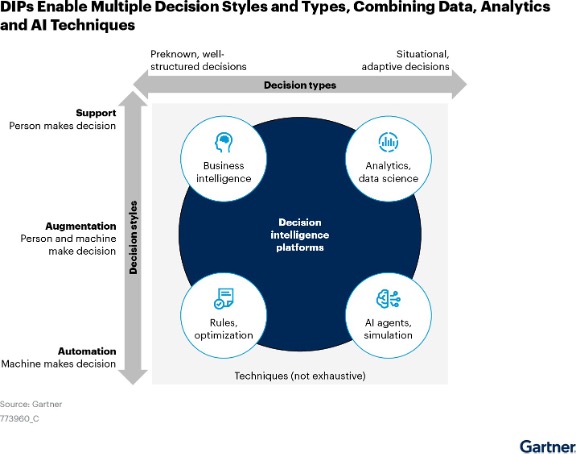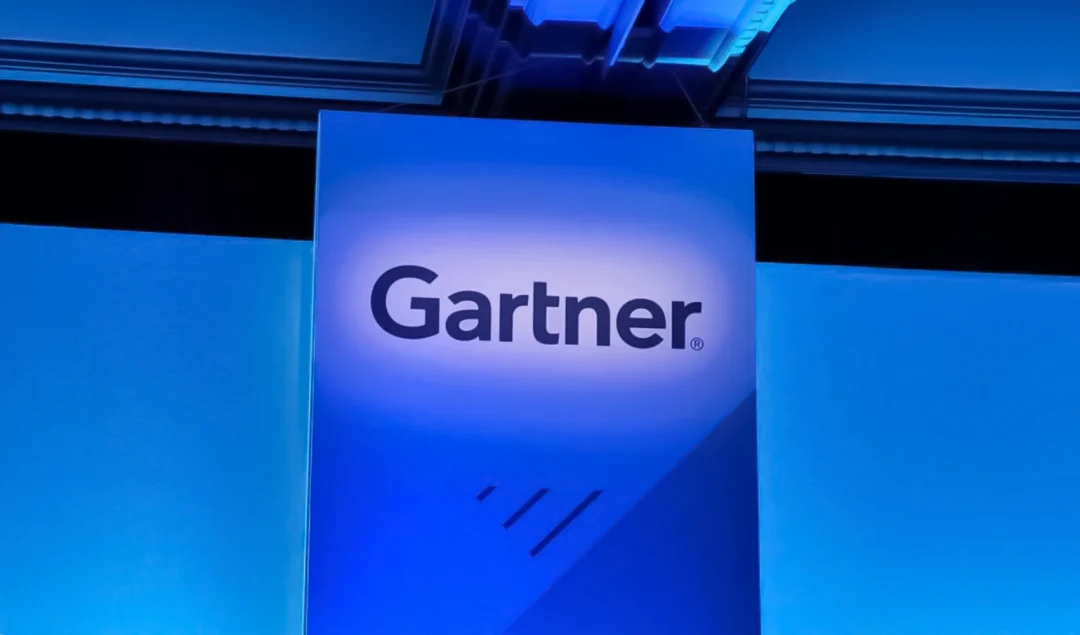Gartner® has published its Market Guide dedicated to Decision Intelligence platforms, known in the industry as DIP, one of the areas of research and development with the highest growth potential for companies worldwide. Spindox has been included among as a DIP vendors with the Ublique© platform, our suite of vertical solutions created to help managers design and manage challenging systems and processes.
To us, The Gartner® Market Guide is not limited to a list of Decision Intelligence Platform (DIP) providers. Instead, it explores the role of AI in the future development of this fastest growing market, which is central in the role it can play in decision-making in complex scenarios.
Decision Intelligence platforms
Decision intelligence platforms are becoming essential tools for business success.
DIPs are software programs that support, automate, and improve the decision-making process of humans or machines. They feed on and process data, information, and knowledge, using Artificial Intelligence techniques.
According to Gartner®,
“Decision intelligence platforms combine explicit decision modeling, AI, analytics and related capabilities to support, augment or automate decision making, driving business outcomes.”
Decision Intelligence platforms therefore combine data management with Artificial Intelligence, optimizing decision-making and business results.
DIP automation can affect both pre-known decisions and, more frequently, unknown or situational decisions, allowing organizations to deal more effectively with unexpected problems (and opportunities).
Especially in this last case, Artificial Intelligence becomes a strategic element of competitive differentiation, increasing the adaptability, effectiveness, and autonomy of business operations.
Figure 1 below shows the different types of DPI, depending on the decision-making nature (human or machine) and the type of decision (pre-known or adaptive).

Figure 1. DIPs enable multiple decision styles and types, combining data, analytics, and AI techniques.
The Decision Intelligence Platform Market
According to Gartner® report, overall demand for DIP will grow very quickly, driven by strong competition in the sector.
Market demands increasingly scalable decisions that are also contextualized and customized: the general context – characterized by complexity, long supply chains, strong global competition, and consumer awareness – requires companies to make decisions faster and more effectively than ever before.
At the same time, the supply of DIP is influenced by technological improvements, in particular by Artificial Intelligence.
By 2026, 50% of companies are expected to combine analytics and business intelligence (ABI) platforms with data science and machine learning (DSML) platforms into a single platform. Furthermore, 75% of Global 500 companies will apply decision intelligence practices. As stated in the report: “By 2026, 50% of organizations will have to evaluate analytics and business intelligence (ABI) and data science and machine learning (DSML) platforms as a single platform due to market convergence. By 2026, 75% of Global 500 companies will apply decision intelligence practices, including the logging of decisions for subsequent analysis.”
Complexity
The decision-making process in companies is becoming increasingly complex, connected, and integrated in the majority of organizations, due to global competition, more demanding customers, the fast pace of digital business, and growing regulatory pressure regarding fairness and transparency in business.
The complexity of the competitive context has consequently affected companies: a third of those surveyed by Gartner® have already implemented Artificial Intelligence; among companies without AI, 17% plan to introduce it in six months, 19% in 12 months, and 25% in 12-24 months. Only 7% said they were not interested.
Specificity of information
To improve the quality of decisions, it is no longer possible to offer fragmented information unrelated to the specific context.
The same can be applied to data and analytics: rather than offering generic solutions (e.g., business unit-level dashboards), DIPs enhance the impact of data-driven insights by delivering them through a decision-centric user interface (e.g., analytics contextualized to the decision maker’s specific decision).
The impact of Artificial Intelligence
The impact of Artificial Intelligence provides life-changing opportunities to enhance decision-making processes, making them a strategic competitive differentiation tool for businesses. Gartner® notes that “the growing power of AI offers game-changing opportunities to bring decision making to a higher level of strategic competitive differentiation.”
However, lots of companies find it difficult to transform the potential of Artificial Intelligence into reality, due to a disconnection between technological possibilities and actual decision-making in the enterprise.
In any case, it just seems like a matter of time: the combo between human ingenuity and AI’s ability to handle data and/or info will make it possible to have versatility, automation, and effectiveness in DIPs that’s still unimaginable.
DIP providers and market competition
Some of the players in the DIP market are pure-play providers: they are entirely focused on this sector and are often newly established.
Other vendors, mostly established players, have expanded their DIP offerings by combining or extending techniques already supported in existing tools, adding specific DIP capabilities such as decision modelling and composability. These vendors often offer other services or products in domains such as business intelligence (BI), data science and machine learning (DSML), generative artificial intelligence (GenAI), or natural language processing (NLP).
However, not all Decision Intelligence providers are DIP providers. To qualify as DIP, platforms must have certain specific features, above all decision modelling. However, there are several providers that claim to offer DI functionality but do not offer all the mandatory features to qualify as DIP providers.
DPI functions and techniques
Decision Intelligence platforms are designed and developed using different techniques each time, involving different roles and areas of the company.
Logic
Techniques based on logic (computational logic or rule-based systems) increase the ability to use and extend corporate know-how. These IPR systems are designed to organize knowledge in a structured way, most often as rules. Formal or informal guidelines can be established, or rules based on machine learning or optimization analysis.
Machine Learning
Machine learning (ML)-based DPI focuses on extracting value from large amounts of data, aiming to uncover knowledge or correlations between data.
These systems include different types of learning (deep, supervised, unsupervised) of textual data or images.
Business Intelligence
Business intelligence (BI) techniques empower non-technical and inexperienced staff to model, analyse, explore, share, and manage data, as well as collaborate and share results. BI functions, enhanced by Artificial Intelligence, include reporting, dashboards, data visualization, data storytelling, and natural language queries (conversational interfaces and chatbots).
Language processing
Natural language processing (NLP) techniques can successfully interpret (and use) intuitive communication among humans. They are capable of understanding aspects related to context, semantics, grammar, and vocabulary.
These DPI techniques are among the ones developing most rapidly; in addition to human language generation, consider, for example, translation, summarization, and speech-to-text (and vice versa) conversion activities.
Optimization
Optimization techniques offer capabilities, traditionally used by operational research teams, to maximize benefits while managing business trade-offs. In this case, DPI is aimed at identifying the optimal combinations of resources, considering the constraints involved and the time available.
Artificial Intelligence
DPIs focused on the use of AI and simulation techniques are those where the greatest resources are concentrated, enabling decisions to be made, actions to be taken, and objectives to be achieved in digital or physical environments.
Systems in this case can work alone or in combination with other software/hardware: chatbots, virtual personal assistants, intelligent robots, avatars, autonomous vehicles, and humans involved in the decision-making process.
Ublique© is one of the global Decision Intelligence platforms
The Gartner® Market Guide has included Spindox’s Ublique© platform among DIPs globally, Which to us is recognizing Spindox’s role in development and innovation in the field of Decision Intelligence.
However, what kind of support can Ublique© provide to companies?
Our platform helps customers in modelling their decision-making flows, utilizing the most appropriate algorithms and analytical tools on a case-by-case basis, including in combination with each other, according to the logic of “composable AI.”
The platform can integrate data management with AI models: mathematical optimization, machine learning, and dynamic simulation.
The purpose is still to improve business decisions by analysing and reviewing how they are made, making them increasingly optimized and automated.
Ublique© allows you to take decision-making to a higher level, making it adaptive and context-sensitive, using the power of techniques such as simulation and Artificial Intelligence. A passage from Gartner® states: “DIPs enable organizations to reimagine how they make business decisions — more accurate, transparent, consistent, scalable and adaptable.”
As Mauro Marengo, CEO of Spindox, said “The time has come to move from a data-driven model to a decision-driven one. Decision Intelligence consists in modelling the decision-making flow and, consequently, the supporting data, not vice versa.”
Disclaimer:
GARTNER® is a registered trademark and service mark of Gartner®, Inc. and/or its affiliates in the U.S. and internationally and is used herein with permission. All rights reserved.
Gartner does not endorse any vendor, product or service depicted in its research publications, and does not advise technology users to select only those vendors with the highest ratings or other designation. Gartner research publications consist of the opinions of Gartner’s research organization and should not be construed as statements of fact. Gartner disclaims all warranties, expressed or implied, with respect to this research, including any warranties of merchantability or fitness for a particular purpose.



